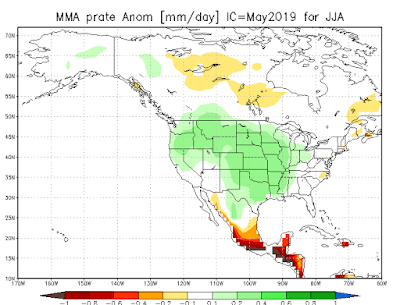As noted above, a large proportion of the state has been declared in drought status, with a recent press release describing a "drought emergency". The definition of drought is found in Washington law, as noted below. Note that the definition is not directly connected with the actual snowpack or precipitation, but rather the "water supply" forecast, with drought being called when the water supply is predicted to be below 75% of normal and "likely to create undue hardship." So there is a substantial subjective element to the definition.

Thus, although below-normal precipitation over the water year (since October 1) is found over western WA (see below), there is a huge hole of no drought in the figure above, because the Tacoma, Seattle, and Everett systems have plenty of water in their reservoirs. Thus, there is no water issues for that huge block of WA State population.
There have been several stories in local media and talk by some politicians that extreme low snowpack is being observed, with numbers in the single or low-double digits being thrown around. Much of this talk is ill-informed. Let me explain.
The snowpack map from yesterday shows the Olympics only being at 6%.
But there really is very little problem and plenty of water. Why? Because, the key issue is that we had a warm spell and the snow is melting out a week or two early, giving nutty numbers during the final days.
Want proof? Here are the observations at the Dungeness SNOTEL site, location at 4010 ft in the NE Olympics. Cumulative precipitation as of this AM (black line) was just slightly below normal (gray line). The snowpack (blue line) was slightly below normal (red line) for the winter, but melted out a week early. No big deal. No emergency. But is produced extreme low numbers for % of normal for a short period.
What about the coastal zone of Washington, which is in the center of the driest conditions?
Similar story. This year was drier than normal, but nothing special. And even the coast was above 75% of normal precipitation.
The bottom line of all this is that this year was drier than normal over the western third of the state, but nothing exceptional.
Modestly drier than normal years happen. Most reservoirs are in good shape, the snowpack is melting a bit faster than normal, and as I will show below, more precipitation is on the way. No emergency.
As described in my previous blog, the latest seasonal forecasts are predicting a wetter than normal summer (the Seattle Times had a headline that said the opposite, but it was in error). But one must note that such forecasts are not reliable nor particularly accurate. But shorter-term forecasts are much more useful and they show precipitation next week.
The European Center ensemble (many model runs) for the accumulated precipitation at Seattle over the next ten days shows most runs bringing rain back next week.
And the totals through next Saturday for the European Center high-resolution system will be appreciable in the mountains and in BC. Wetting down BC is good for us, since that will work against early fires there. Lots of precipitation in Oregon and CA. Again, this will work against early fires.
In short, we have had a winter with modestly below normal precipitation and an April 1 snowpack of about 75% of normal over the State. Not unexpected in an El Nino year. Our reservoir and dam systems are sufficient to provide normal water availability for nearly every user in such a circumstance-- in fact, it would be scandalous if they couldn't. If we couldn't easily handle such a year, folks would need to question our Governor and State legislators about why they weren't ensuring a robust water system.
And there is no reason to expect a dry summer and healthy dose of precipitation is in the forecast.
Clearly, the State legislature and Governor should revisit the drought definition being used and perhaps come up with new terminology (e.g., dry condition advisory). The term "emergency" is a powerful one and should only be used in truly dire situations.























































